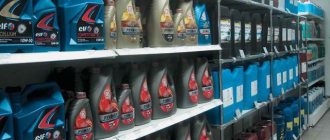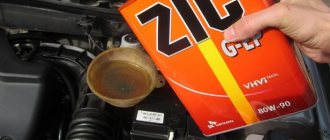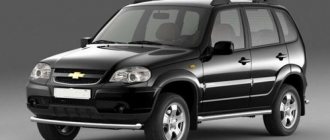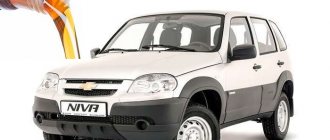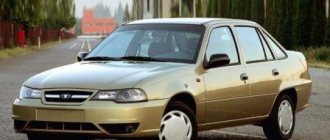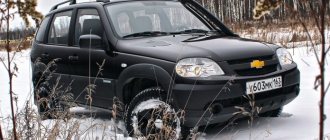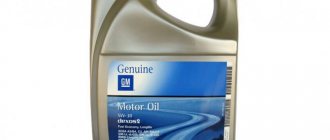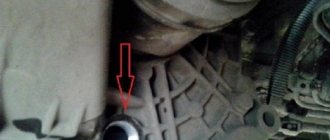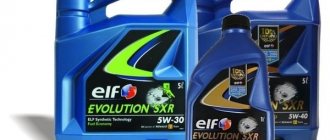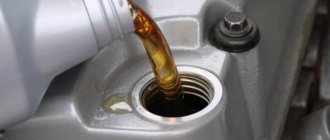Chevrolet Niva filling volumes
Some people use very thin oils 0 – 40, but they cost much more and won’t make much of a difference.
If the car engine does not have hydraulic compensators, you can use 10 - 40 regardless of the season, and in the case of hydraulic compensators, fill in 5 - 40. The number of these elements in each car may vary. In addition, it is important to have a clear understanding of the location, types, engine and transmission oil used, types of lubricants and fluids.
- After all, Chevrolet Niva filling tanks must be filled taking into account the plant’s recommendations so that all systems can fully operate.
- Video
FILLING CAPACITIES
| Refillable system | Volume, l |
| Fuel tank (including reserve) | 42 (65*) |
| Engine cooling system (including interior heating system) | 10,7 |
| Engine lubrication system (including oil filter) | 3,75 |
| Gearbox housing | 1,6 |
| Rear axle housing | 1,3 |
| Steering gear housing | 0,18 |
| Transfer case housing | 0,79 |
| Front axle housing | 1,15 |
| Hydraulic clutch system | 0,2 |
| Hydraulic brake system | 0,535 |
| Windshield and headlight washer reservoir | 2,8 |
| Rear window washer reservoir | 2,0 |
| Power steering reservoir | 1,7 |
* For VAZ-2131 cars and its modifications.
| Refueling or lubrication point | Quantity, l | Name of materials |
| Fuel tank | 42 | Motor gasoline with octane number 91–93, 95* |
| Engine cooling system including interior heating system | 10,7 | Coolant with a freezing point no higher than –40°C |
| Engine lubrication system, including oil filter, at ambient temperature: | 3,75 | Motor oils (with API quality level: SG, SH, SJ) |
| from –20° to 45°С | SAE 15W-40 | |
| from –25° to 35°С | SAE 10W-30 | |
| from –25° to 45°С | SAE 10W-40 | |
| from –30° to 35°С | SAE 5W-30 | |
| from –30° to 45°С | SAE 5W-40 | |
| Gearbox housing | 1,35 | Gear oils with quality level according to API GL-5 and viscosity 75W-90 |
| Transfer case housing | 0,75 | |
| Front axle housing | 1, 15 | |
| Rear axle housing | 1,3 | |
| Steering gear housing | 0, 18 | Gear oil 75W-90 |
| Hydraulic clutch release system Hydraulic brake system | 0,2 0,515 | Brake fluid DOT-3, -4 |
| Windshield washer reservoir Tailgate washer reservoir | 2,0 (5,0) | A mixture of water and windshield washer fluid |
| Starter drive drive ring | — | Litol-24 lubricant or imported analogues |
| Front wheel bearings | — | Litol-24 lubricant or imported analogues |
| Cardan joint cross bearings | — | Lubricant Fiol-2U, No. 158 or imported analogues |
| Front propeller shaft spline | — | Lubricant Fiol-1, CV joint-4 or imported analogues |
| Door limiters | — | Grease Shrus-4 |
| Seat moving slides | Fiol-1 lubricant or imported analogues | |
| Tie rod joints and front suspension ball pins | — | ShRB-4 lubricant or imported analogues |
| Battery leads and terminals, door keyholes | Automatic lubricant VTV-1 in aerosol packaging, CIATIM-201, -221, Litol-24 or imported analogues | |
| Door locks | — | Fiol-1 lubricant or imported analogues |
| Rear brake pressure regulator | — | Lubricant DT-1 or imported analogues |
*For vehicles with fuel injection system equipped with an exhaust gas converter
- FILLING CAPACITIES, OILS AND LIQUIDS.
- Oils and liquids
- Motor gasoline with octane number 93, 95**
- Engine cooling system
- (including interior heating system)
- Coolant with a freezing point no higher than –40°C
- Latest recommendation from AvtoVAZ
- Sintec Antifreeze Lux G12
- Engine lubrication system
- (including oil filter)
- Motor oils (with API quality level: SG, SH, SJ, SL,SM, SN)
- Gearbox housing
- Gear oils with quality level according to API GL-5 and viscosity 75W-90
- Rear axle housing
- Steering gear housing
- Transfer case housing
- Front axle housing
- Hydraulic clutch system
- DOT-4 brake fluid
- Hydraulic brake system
- Windshield and headlight washer reservoir
- A mixture of water and windshield washer fluid
- Rear window washer reservoir
- Power steering reservoir
- Fluid for refilling the hydraulic steering system Pentosin SHF11S
- * For VAZ-2131 cars and its modifications.
- **For vehicles with fuel injection system equipped with an exhaust gas converter
And also interesting: Fuel consumption of Niva 2121: standards recommended by the manufacturer for the carburetor and injector.
The recording is more for yourself, but maybe it will be useful for someone else. Since after the purchase I only changed the oil in the engine, and it’s not at all clear what and how much in the transmission, I’m thinking about changing the oils in the gearbox, transfer case and axles. It would be good to know what kind of transmission oil to fill in to reduce the howling of the transfer case.
Fuel tank 58.
0 l Engine cooling system 8.0 l Engine lubrication system 3.75 l Gearbox housing 1.6 l Transfer case housing 0.79 l Front axle housing 1.15 l Rear axle housing 1.3 l Brake hydraulic system 0.5 l Clutch release hydraulic system 0.15 Windshield washer reservoir 5.0 l Tailgate washer reservoir 2.0 l Front shock absorber 0.15 l Rear shock absorber 0.215 l Power steering 1.7 l Air conditioning: refrigerant 0.650 kg
Conditioner: oil 0.22 l
- Places for lubrication, filling, processing
- Motor oils type SUPER (classification according to SAE; API) Engine lubrication system Viscosity class according to SAE: 5W-30: from –25 to 20 С5W-40: from –25 to 35 С10W-30: from -20 to 30 С10W -40: from -20 to 35 С15W-40: from –15 to 45 С20W-40: from –10 to 45 Level of performance properties: according to API SG, SH, SJ according to ASEA A2
- according to CCMC G3, G4
- Transmission oils (classification according to SAE; API) Gearbox, Transfer case Viscosity grade according to SAE: 75 W-90; 80 W-85; 80 W-90; Level of performance properties: according to API: GL-4 or universal: GL-4/ GL-5 Front axle, Rear axle, Steering gear Viscosity grade according to SAE: 80 W-90; 85 W-90; Level of performance properties: according to API: GL-5 or universal: GL-4/ GL-5
- Power steering: Pentosin Hidraulik Fluid CHF11S VW52137
How to avoid falling asleep while driving on the highway
GreasesFront wheel drive joints CV joints-4M, SPECTROL CV joints MoS2 TU 0254-001-0014882Front suspension ball joints, Steering rod joints ShRB-4 TU 38.
USSR-201-143 Joints for cardan shafts Litin 2 TU 0254-311-00148820 Splined joints for cardan shafts 158 TU 38.
Dowcorning
Pressure regulator DT-1 TU 38-USSR-201-116
Brake and clutch hydraulic drive system Brake fluids type DOT-4 SAE J 1703, FMSS116
In this article we will talk about how to change the oil in the gearbox, transfer case and axles of a Chevrolet Niva. The use of high-quality lubricants for vehicles plays an important role in the operation of any car. The most common process for proper vehicle operation is the oil change process. It is possible to change the oil yourself, without resorting to the help of auto service employees, while significantly saving money.
Choosing engine oil is a responsible task on which the service life of the power plant depends. This procedure is no less important than the oil change process itself. Oil should be selected according to the parameters and tolerances specified in the operating instructions.
You cannot make a mistake in your choice, as this mistake can result in a serious technical breakdown, and incompatible oil can cause a major overhaul of the engine.
In this article, using the example of the popular Chevrolet Niva SUV, we will pay attention to the most important parameters of motor oil, and also consider the best brands of oils and how much oil should be filled.
Lubricants consist of a base (base) and additives. Their chemical and physical properties depend on the composition and origin of these components.
According to the method of manufacturing the base, the transmission is divided into three types:
- Mineral is a product remaining after the distillation of oil in the production of diesel fuel and gasoline. Includes heavy fractions of hydrocarbons and contains large amounts of sulfur. Its properties are determined by naphthenes, aromatics and paraffins. The oil entering oil refineries differs in its composition. This does not allow achieving stable mixture proportions. Therefore, the final parameters are adjusted with additives. Under the influence of temperature, heavy fractions of hydrocarbons disintegrate, and additives oxidize and lose their properties. This oil has to be changed more often. Another disadvantage of “mineral water” is that oxidation products settle on parts.
- The synthetic base is artificially created from the desired hydrocarbons. Thanks to this, it is possible to obtain a product with predictable viscosity values without the use of additives. Additives are used only to improve the lubricating and antioxidant properties of the transmission.
- Semi-synthetic oils are created on the basis of a mixture of mineral and synthetic bases (at least 30% of the latter is used). This approach allows you to reduce the number of additives that change viscosity.
Also interesting: Pros and cons of the Chevrolet Niva car suspension
Synthetic gear oil differs from mineral and semi-synthetic oil in that its viscosity changes less with temperature changes. This reduces wear on transmission parts during winter operation of the Chevrolet Niva. But “synthetics”, due to their greater fluidity, seep through worn gearbox seals more easily.
However, the main characteristic of a lubricant is viscosity. This is what is indicated in the operating instructions. The manufacturing company recommends filling in the following types of gear oils (according to SAE):
- Transfer case and gearbox - 75W-90, 80W-85, 80W-90.
- Drive axles (front and rear) - 80W-90, 85W90.
Therefore, API GL4 and GL4/GL5 must be poured into the gearbox (gearbox), and GL4/GL5 and GL5 into the axles and transfer case.
There are dozens of gear oil brands on the market. The most famous imported ones are Castrol, Liqui Moly, Mobile, Shell, and the most famous domestic ones are Lukoil and Rosneft.
Main elements of the system
The design of the VAZ-2123 provides refueling tanks that ensure smooth functioning of the mechanisms.
The main elements of the system include the following filling containers:
- fuel tank;
- transmission housing;
- power steering;
- cooling system;
- engine lubrication system;
- axle and transfer case housings;
- container for hydraulic drive of the brake system;
- tanks for washer fluid;
- containers for refilling the air conditioner.
The following is a table of fuel volumes for the Chevrolet Niva:
To improve the performance characteristics of an SUV, working fluids must be poured in quantities recommended by the developers of the Chevrolet Niva.
Fuel tank
All-wheel drive and increased cross-country ability of the Chevrolet Niva increase fuel consumption. Therefore, this AvtoVAZ model has a 58-liter fuel tank. It is located in the rear of the car. The fuel tank is made of high-strength steel and has a complex design.
Because gasoline tends to evaporate, excess pressure can build up inside the gas tank, increasing the risk of explosion. To reduce pressure, the designers of the VAZ-2123 provided an adsorber valve, with the help of which excess gasoline vapors are released.
The fuel tank housing has a stamping for the driveshaft channel, which divides the gas tank into two communicating reservoirs. Therefore, about 7 liters of fuel remains in the tank, which does not enter the fuel line. However, the design of the gas tank allows fuel to be filled under the neck, which allows you to fill up to 64 liters of fuel. This feature compensates for the unconsumable remaining gasoline.
Attention! When a steel gas tank oxidizes, rust residues and other small particles enter the fuel, which leads to excessive fuel consumption, as well as premature wear of fuel system and engine parts. To avoid these troubles, periodic removal and cleaning of the fuel tank is recommended.
Cooling system
When the car engine is running, the temperature of the exhaust gases reaches 2000 degrees. Due to the elevated temperature, the lubricant burns out. This leads to engine malfunctions and wear of parts. To avoid engine overheating, VAZ-2123 vehicles are equipped with a closed-type liquid cooling system, which consists of the following components:
- radiator;
- expansion tank;
- fan;
- water pump.
For cooling, antifreeze is used with the addition of additives that have anti-corrosion properties. The operating principle of the cooling system is based on the forced circulation of antifreeze through the cooling jacket around the engine cylinders.
The pump ensures uniform circulation of the coolant. After starting the engine, the pump begins to pump antifreeze through the small circuit of the cooling system. When the engine heats up, the thermostat activates, after which a large circuit opens. The expansion tank is needed to relieve excess pressure that occurs when the antifreeze heats up. Passing through the radiator, the liquid is cooled by a fan.
Carefully! To avoid burns and vapor poisoning, antifreeze should be poured into the cooling system when the engine is turned off and cooled down. In an emergency, ordinary water can be used for cooling, however, it must be replaced with antifreeze as soon as possible.
Engine lubrication system
Friction and high temperatures reduce the service life of the engine and the service life of the vehicle. To avoid premature wear of engine parts, it is necessary to monitor the oil level. In the Chevrolet Niva, the designers have developed a combined engine lubrication system. The crankshaft and camshaft bearings, pushrod tips and rocker arm bushings are pressure lubricated. The remaining parts are lubricated using the spray method.
Using an oil pump, oil from the crankcase through the oil receiver enters the filter housing. After cleaning, the lubricant is supplied to the oil line, from where it is supplied to the parts under pressure through inclined channels. The pressure at medium speeds in a working VAZ-2123 lubrication system is from 200 to 400 kPa. A decrease or increase in pressure indicates a system malfunction.
What is the best gear oil to fill?
Time-tested and widespread brands of lubricating fluids for the Chevrolet Niva gearbox:
- Gazpromneft. Relatively inexpensive domestic brand, good quality.
- Eneos. Stably maintains fluidity at temperatures down to -30 degrees.
- Lukoil.
- Castrol. Softens transmission operation and reduces noise.
- TNK. Russian manufacturer of mineral oils. Recommended for use with low mileage and low vehicle use.
- Shell. It is used in sports cars and performs well in Niva. Usually helps with noise in transmission units. Recommended for use during active off-road use.
- Mobil. High quality oils, containing modern anti-wear additives. Copes well with heavy loads in the transmission in any speed range.
Of course, there are other brands of lubricant manufacturers, but you should trust the brands presented. The manufacturer recommends changing the lubricant every 45 thousand kilometers. But it all depends on the conditions and activity of exploitation.
The most common engine installed on the VAZ 2121 is 8 valves, 83 l/s, volume 1.7 liters. With such a volume, the engine is more torquey than revvy. In this case, the temperature regime is very important - you should choose which oil to pour into the NIVA engine based on weather conditions. The parameters recommended by the manufacturer are only suitable for an engine that has not passed the warranty mileage. There is a table generated based on the manufacturer's requirements.
Filling with a different lubricant is more expensive for yourself, since you may lose the warranty. Most NIVA owners change the oil themselves after the warranty period, saving money on maintenance. To extend engine life, it is important to choose the correct lubricant viscosity. This parameter directly depends on the weather. The general principle is that the higher the temperature, the higher the viscosity.
The engine is cooled not only by antifreeze, but also by oil. Too thin a lubricant heats up quickly, and heat transfer deteriorates. In addition, it is possible to leak through gaskets and seals. A heated liquid with a low coefficient will not hold the so-called well. grease stain. The other side of the coin is if you fill it with thick oil in winter.
The Lukoil company is the official partner of AvtoVAZ. It is this brand of semi-synthetics that is poured into the transmission during the production of the Chevy Niva.
When to change
For prevention, according to the manufacturer's instructions, you should periodically change the lubricant of both axles of the car every 45 thousand kilometers or after three years of operation. If the machine is often used off-road or at low temperatures, then this interval should be reduced. Also, the appearance of external disturbances in the operation of the transmission, caused by a whistle, increased hum, knocking when starting from a stop and at speed, signals the need to check the level and quality of the transmission fluid.
After purchasing a used car, after major repairs, you also need to change the lubricant. The longer the mileage becomes (especially after 100 thousand kilometers), the more often such maintenance should be carried out.
What does the manufacturer recommend?
It is important to remember that it is strictly forbidden to add lubricants of the most common API GL-5 standard to the Chevrolet Niva gearbox. On the one hand, it is better in terms of performance: it performs well at high speeds, high loads and temperatures. On the other hand, it contains sulfur-phosphorus extreme pressure additives, which in high concentrations can disrupt the operation of the Niva manual transmission synchronizers. Most car enthusiasts recommend using transmission fluids of the GL-5 standard for addition to axles and gearboxes.
The transfer case and gearbox should be filled with oil that meets API GL4 or GL4/GL5 quality standards and SAE viscosity 75W-90, 80W-85, 80W-90. Transmission fluid according to API GL5 or GL4/GL5 is intended for gearboxes, front and rear axles. It is better not to use oil with GL4 standard.
Replacing brake fluid
Based on the technical characteristics of the car, brake fluid is added to the hydraulic brakes once every three years or after 50 thousand km. To do this, you need to pump out the old fluid from the tank, fill in new one and pump the hydraulic drive until the remnants of the old fluid are removed from the system. Bleeding is carried out with the engine turned off in the following sequence:
- Rear wheel brakes on the right side.
- Left front wheel.
- Rear wheel brake on the left side.
- Right front wheel brakes.
After bleeding the brake system, the missing volume of fluid is added to the reservoir.
What is the best gear oil to fill?
We will leave environmental issues to Greenpeace; for NIVA owners, the main thing is reliability. The point is in the base from which the technical fluid is made. Mineral water or semi-synthetic is cheaper to produce, but the resistance to delamination is much lower. On the other hand, replacing transmission fluid on NIVA SUVs occurs quite often; even the most unstable base simply does not have time to lose its factory properties. The waste consumption of synthetics is higher, since the penetrating ability of such a base is better.
Also interesting: Purpose, diagram, design of the unequal angular velocity joint
Replacing windshield washer fluid
While driving, dirt settles on the car windows, which impairs visibility. Windshield washers help clean windows. The VAZ-2123 car is equipped with windshield and rear window washers. The windshield washer fluid reservoir is located in the engine compartment. To prevent the windshield washer motor from malfunctioning, you need to monitor the fluid level in the reservoir and clean the filter of contaminants.
If necessary, fill washer fluid up to the neck of the reservoir. In the warm season, ordinary water can be used for these purposes. In winter, pour in antifreeze liquid. Rear window washer under the door trim. Simply unscrew the cap to add washer fluid.
This is interesting: Is it possible to mix green antifreeze from different manufacturers?
What kind of oil should I put in the NIVA box?
Since gearbox lubricants are not so expensive, you don’t have to skimp on quality. If you pour frankly cheap fluid of dubious origin, the gear will not engage at the right time. And repairing the gearbox will cost more than the money saved. Just like for the engine, there are temperature tolerances for viscosity.
Parameters in the table. The box is more sensitive to the quality of liquids, since in off-road modes it works with increased loads. Despite the fact that when you buy a NIVA, mineral water is poured into the transmission, at the first replacement it is recommended to flush the gearbox and fill it with synthetics. This does not contradict the warranty, but the box will last longer.
Recommended intervals
The vehicle service manual clearly defines the service interval for servicing transmission units. Here it is 45,000 kilometers. But there is an important nuance in the segment - the manufacturer implies moderate operation of the machine in low-load mode.
In reality, everything is less trivial. To select the correct time period, you should take into account the aggressiveness of the vehicle, the quality of the lubricant and the condition of the transmission. Experienced car enthusiasts prefer not to delay the maintenance of units and change the lubricant already at 25,000-30,000 km. This helps prevent excessive fluid wear and reduces the risk of block damage. But some people don’t care and ride 200 thousand and everything is fine.
Oil volume in Niva Chevrolet transfer case
The all-wheel drive monster of the Chevrolet Niva works flawlessly, you just need to follow the instructions, carry out timely maintenance of the transfer case, monitor the amount of oil in it, and also change all the technological fluids.
The pride of the domestic automobile industry is the Chevrolet Niva. The manufacturer has produced a truly luxurious car, its characteristics not inferior to its expensive analogues. For off-roading, trips to nature, fishing, hunting - you won’t find a better car.
In order to choose the right lubricant for the transfer case, several factors should be taken into account. One of the most important is compatibility with other liquids used. Before purchasing, be sure to check the viscosity of the lubricant. At the same time, it is not at all necessary to purchase products from one manufacturer.
It is also not recommended to use lubricants with different chemical compositions so that they do not mix. This is very important if you want to truly improve the performance of your car. Therefore, if you fill a Chevrolet Niva with semi-synthetics, then in the case of the transfer case, purchase a semi-synthetic lubricant.
Carrying out an oil change
Let's look in detail at how to change the oil in axles. The main steps of the procedure are identical to changing the lubricant in the transfer case. First, the fluid in the gearboxes warms up. To do this you need to drive about five kilometers. Then the car is driven onto a viewing hole, overpass or lift. The waste is poured into prepared containers. Its condition is assessed for the presence of dirt and metal particles. New lubricant is added. Possible leaks are checked. You also need to clean the breathers of both bridges. The filler holes are inspection holes for checking the lubricant level. The liquid should be level with these holes.
What to choose for bridges
In most cases, the oil chosen for axles is the same as for the transfer case. Their full compliance guarantees you high functionality of all components of the transmission during active daily use of the car. Most car enthusiasts agree that you should only buy proven lubricants. These include products from the following brands:
- Castrol;
- Lukoil;
- Liqui Moly;
- Mobil;
- Shell;
- Elf;
- ZIC.
This is a list of the most popular and widely used brands. Their products are used by a huge number of car enthusiasts with different experience levels. When purchasing, be sure to check the compatibility of the viscosity and chemical composition with the oil already used in the gearbox.
Read news about the new Niva
- How to fix an oil leak from a gearbox
- UAZ or Niva - which is better, car characteristics and features ::
- FROST car air conditioners // Online store // Prices // Air conditioners for cars Lada VAZ, VolksWagen Polo, Daewoo Matiz
- Niva Chevrolet transfer case: device, connection diagram and how to use?
- Quantity of oils and fuel liquids VAZ 4×4 2121 Niva
- Transmission Niva Chevrolet: diagram and principle of operation
- How much oil is in the Niva 21214 engine
- What kind of oil to pour into the VAZ 21214 Niva engine injector
How much to fill
The volume of fluid poured into the Chevrolet Niva gearbox is 1.6 liters. This is how much oil will fit after completely cleaning the gearbox from old substances and various deposits. A complete transmission flush is necessary for high mileage. The procedure is performed at a dealership or at home. The most important thing here is the flushing stage, during which a special substance is circulated throughout the entire transmission with the engine running. Then the flushing liquid is drained from the box, and then new oil is introduced in the specified volume of 1.6 liters. The liquid level is adjusted to normal using a dipstick.
View oil prices
Gear diagram
Shifting gears is the same as on most cars. This was done with the goal of unifying vehicles so that drivers, when changing to another car, experience as few problems as possible.
But, at the same time, there are some differences in the design of this car. The transmission on the Niva Chevrolet is equipped with two levers. The first is necessary to select the optimal gear. The second is necessary to activate the differential lock.
The choice of the desired gear is determined by the speed of the Niva 21214 car. The recommended parameters can be seen in the table below:
It indicates the maximum speed specific to each specific gear. When it is reached, you need to switch to a higher one.
Preparing for replacement
The process of changing the lubricant yourself will take a little time - an hour or an hour and a half. But you need to prepare first. A set of tools, devices, and consumables is selected. You will need a 12mm hex key and a 17mm socket head, a container for waste fluid, dry rags, and sealant. For filling, you can use a special filling syringe (pump) or another device (funnel with hose). Copper sealing rings are placed on the crankcase plugs. Therefore, you need to prepare them in advance. Work is carried out with protective gloves.
Cooling system
The cooling system here is liquid, closed type. This includes a radiator, pump, sensor. thermostat, fan, expansion tank, hoses, etc. The capacity is 8 liters.
The expansion tank is located next to the brake booster. Installed markers allow you to quickly determine the fluid level. It is important that everything is completely sealed, so the inlet and outlet valve monitor and regulate the pressure.
The tubular-plate radiator is made of aluminum and has plastic tanks. Coolant Antifreeze A-40 M for this system is poured through the expansion tank.
Important! It is also recommended to use antifreeze containing ethylene glycol, which also prevents the formation of rust.
Causes of internal combustion engine overheating and troubleshooting!
What kind of oil to pour into the Niva gearbox and engine
How to replace the coolant temperature sensor on a Chevy Niva - detailed recommendations and videos from professionals
Replacement instructions
It would be logical to find out how much oil is in the VAZ Niva 21214 engine and how much motor fluid is required to purchase. If we talk about the volume of liquid being filled, then for the Niva engine it is 3.75 liters. The actual volume of oil in the engine is usually less than that indicated in the vehicle's data sheet.
This is due to the fact that when draining the waste, some of the oil still remains in the system. It is almost impossible to clean the engine 100% on your own. You should take plenty of oil, but not much. It is better to take a 5 liter canister of high-quality lubricant. This will allow you to fill the full volume into the crankcase, plus periodically add it as the level changes.
To work, you will need to collect some materials and tools. This list includes:
- fresh motor oil in the right quantity;
- an empty container where the waste will be drained;
- funnel for filling;
- fuel filter;
- 12mm hex or 17mm wrench;
- puller for the oil filter (you can do without it);
- inspection hole;
- rags;
- lighting;
- overalls (gloves, closed shoes, thick clothing).
If you have everything ready, you can start working. Be sure to follow the instructions step by step, do not rush and do not try to unscrew or tighten anything by applying great force. Otherwise, you risk breaking some parts, which will lead to more expensive repairs. We begin the procedure for changing the engine oil, changing the filter at the same time.
- Place the car on an inspection hole to have easy access to the bottom where the oil pan is located. The engine should be warmed up first so that the oil acquires a more liquid structure and can easily drain from the sump.
- If you warmed up the engine at idle, wait a few minutes so that all the liquid drains down. You can still unscrew the filler plug in the engine compartment. This will allow the oil to come out from below faster.
- Carefully unscrew the drain plug. It comes in different types, so you will need a hexagon or wrench to dismantle it. Before you begin to unscrew the cap, place an empty container under it. Unscrew completely and let the oil drain. This will take about 10 – 15 minutes. Therefore, at the same time, work on the oil filter.
- If the oil comes out very dirty, then a lot of debris, chips and dirt will remain in the system. In this condition, it is recommended to flush the engine. To do this, use special additives, flushing mixtures or fresh oil.
- There are additives that you simply add to the filler neck while the old grease is still there, start the engine and let it run for a few minutes. Then they are jammed and everything is removed from the pan.
- The option with flushing oil or regular fresh engine oil looks different. First, the old fluid is drained, then the drain plug is closed, fresh oil is added, the engine is turned on and it runs at idle speed for 5 - 10 minutes. Now the pan plug is unscrewed again and drained. If the engine is heavily dirty, it is recommended to repeat the procedure 2–3 times. This takes a lot of oil, but it gives the engine new life.
- Only after complete washing is the old filter removed and a new one installed in its place. The filter is unscrewed with a puller, manually or with an improvised tool. The puller is the most convenient, but is not always available to the car owner. Be careful not to damage adjacent pipes and wiring. For safety reasons, it is better to remove the negative terminal from the battery.
- Clean the holes for the drain plug and the filter if there is dirt there. Otherwise, they may get into the fresh motor fluid.
- Before reinstallation, check the plug gasket and replace it if necessary. The filter seal is lubricated with oil, and engine fluid is filled to 50% of the volume of the new filter. Now you can install them in place.
- Make sure that the filter and plug are firmly in place and that there are no leaks through them.
- We move on to the engine compartment, where we use a funnel to pour fresh composition through the filler neck. Fill in about 3.5 liters first, since some of the oil remains in the system. Close the lid and run the engine at idle speed for 2 - 3 minutes.
- Turn off the engine and let the oil drain. Take the dipstick and check the level. A trace of the oil film should remain between o and “Max”. If the level is closer to the minimum value, open the lid again, add a little more lubricant and repeat the procedure.
When you start the car, the oil pressure light will come on. It's not scary, it always happens. The indicator will go out after a few seconds. Over the next few days, monitor how your Niva behaves. Check under the car for traces of fresh oil. Leaks may occur due to a poorly installed filter or drain plug. Tighten the connections and recheck the level.
Owners of the VAZ Niva 21214 car are advised to periodically monitor the oil level, add it as needed and react promptly if the liquid suddenly changes color, becomes cloudy, its consumption increases or the engine overheats. Signs like these indicate more than just a leak.
Do-it-yourself replacement or car service?
Both options exist. There is nothing difficult in the process of changing engine oil yourself, of course, if you have the appropriate place to carry out this manipulation (this could be an overpass or a lift in the garage).
If this is not possible, then the operation can be performed at a car service station. The procedure is simple and does not cost a lot of money. The only point is to do the specified procedure in a trusted place. Because there are situations when dubious services partially drained the used oil, added some new oil, and that’s it.
These cases are rare, but they do occur, therefore, you should not completely exclude them; if possible, you can attend the oil change procedure to remove such a risk.
Greases
| Lubricant brand | Manufacturer | Regulatory document |
| Vaseline technical VTV-1 | JSC "Rikos", Rostov-on-Don | TU 38.301-40-21 |
| Vaseline technical ONMZ VTV-1 | JSC "Neftemaslozavod", Orenburg | TU 0255-195-05767887 |
| Lubricant AZMOL GRAPHITOL | OJSC "Azmol", Berdyansk | TU U 23.2-00152365-178 |
| LIMOL lubricant | OJSC "Azmol", Berdyansk | TU 38.301-48-54 |
| LITA grease | OJSC "Azmol", Berdyansk | TU 38.101-1308 |
| LITOL-24 lubricant | OJSC "Azmol", Berdyansk | GOST 21150 |
| Grease AZMOL LSC-15 | OJSC "Azmol", Berdyansk | TU U 23.2-00152365-180 |
| UNIROL-1 grease | JSC "Rikos", Rostov-on-Don | TU 38.301-40-23 |
| Grease UNIOL-2M/1 | OJSC "Azmol", Berdyansk | TU 38.5901243 |
| Grease AZMOL FIOL-1 | OJSC "Azmol", Berdyansk | TU U 23.2-00152365-173 |
| Grease AZMOL ShRB-4 | OJSC "Azmol", Berdyansk | TU U 23.2-00152365-172 |
| Lubricant AZMOL SHRUS-4 | OJSC "Azmol", Berdyansk | TU U 23.2-00152365-182 |
| CV joint grease-4M | OJSC "Perm Plant of Lubricants and Coolants", Perm | TU 38.401-58-128 |
| Ortol Sh lubricant | JSC "Neftemaslozavod", Orenburg | TU 0254-001-05767887 |
| Grease CIATIM-201 | OJSC "Azmol", Berdyansk, OJSC "Rikos", Rostov-on-Don, LLC NPF "RUSMA", St. Petersburg, OJSC "Neftemaslozavod", Orenburg | GOST 6267 |
| Grease CIATIM-221 | OJSC "Azmol", Berdyansk, OJSC "Rikos", Rostov-on-Don, LLC NPF "RUSMA", St. Petersburg | GOST 9433 |
Continuation of the table. 9
| Lubricant brand | Manufacturer | Regulatory document |
| Solid lubricant Molybdol M3 | CJSC "Technology", St. Petersburg | TU 301-02-63 |
| Lubricating graphite “P” | OJSC "Azmol", Berdyansk | GOST 8295 |
| Ditor lubricant | JSC "Rikos", Rostov-on-Don | TU 0254-007-05766706 |
| CASTROL S-058 grease | , Germany | TTM 1.97.733 |
| MOLYKOTE X-106 grease | , USA | TTM 1.97.0115 |
| Renolit JP 1619 grease | , Germany | TTM 1.97.0800 |
| Lubricant Lucas PFG-111 | , Germany | TTM 1.97.0733 |
